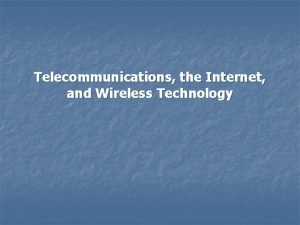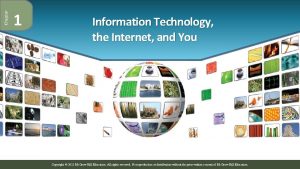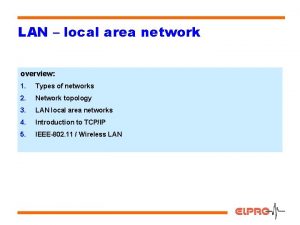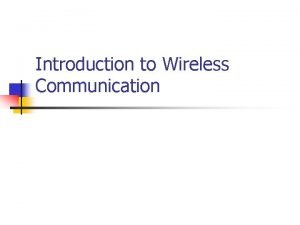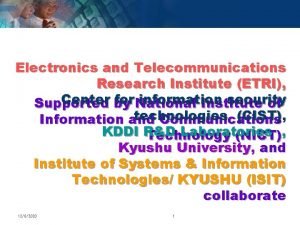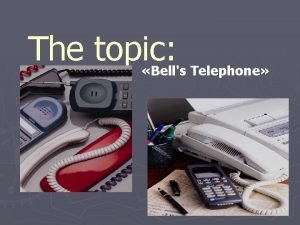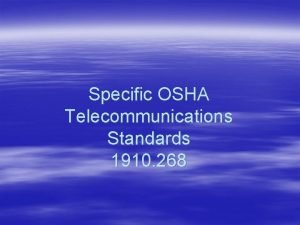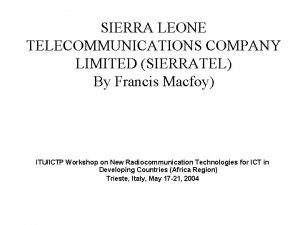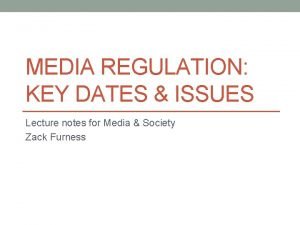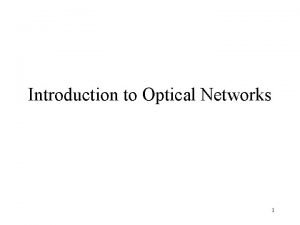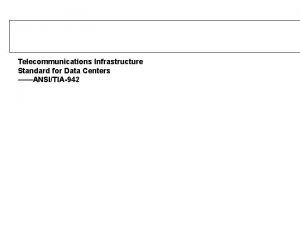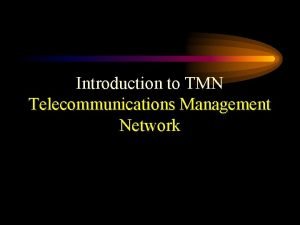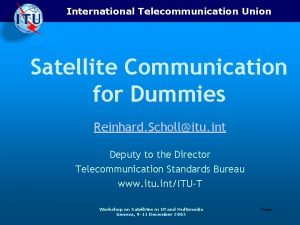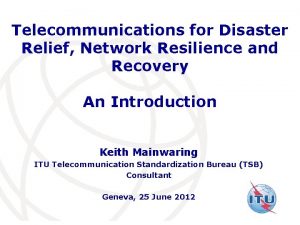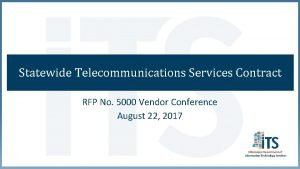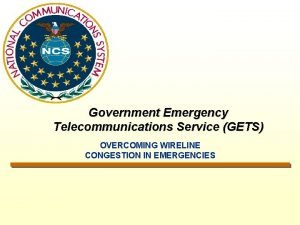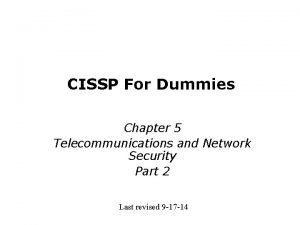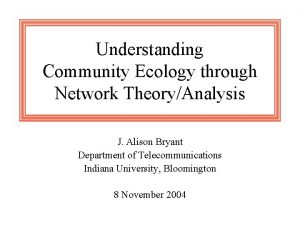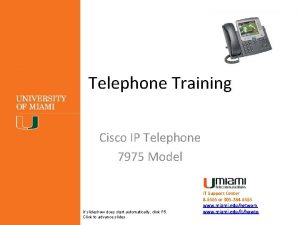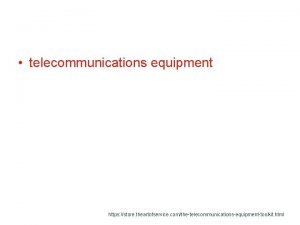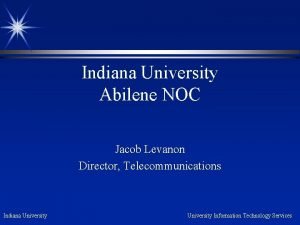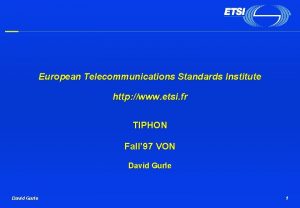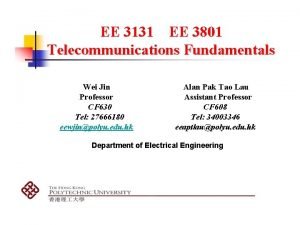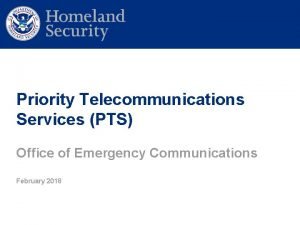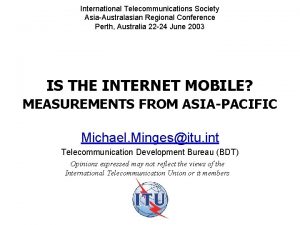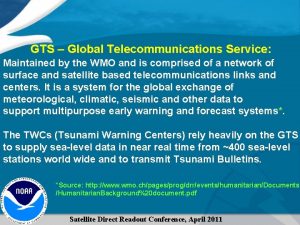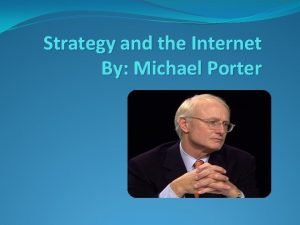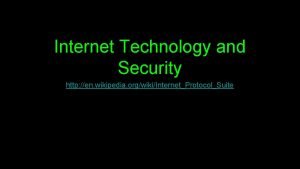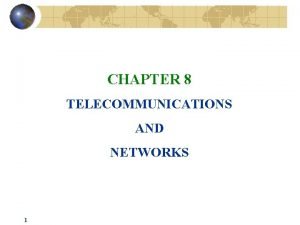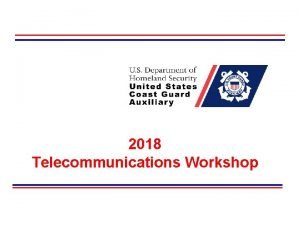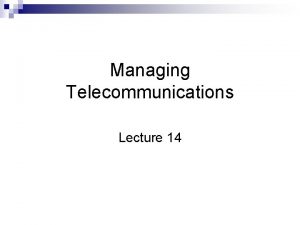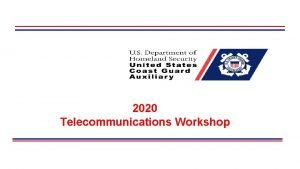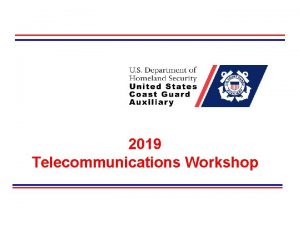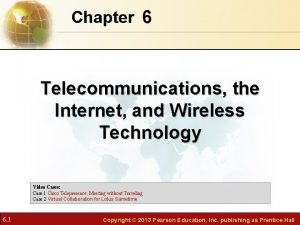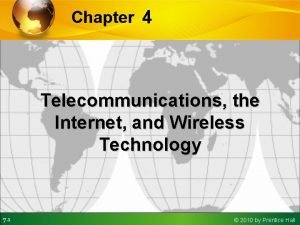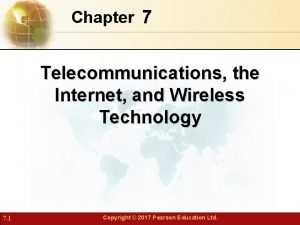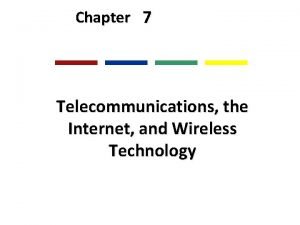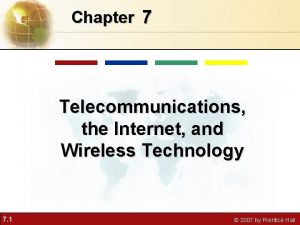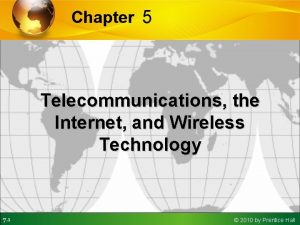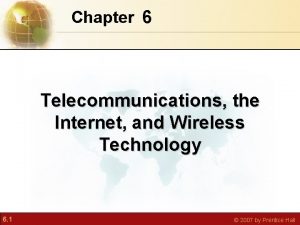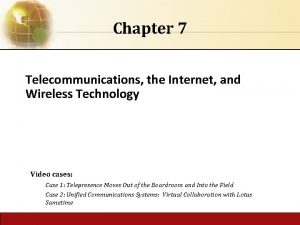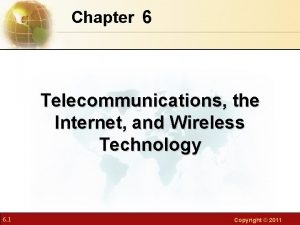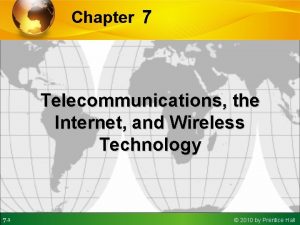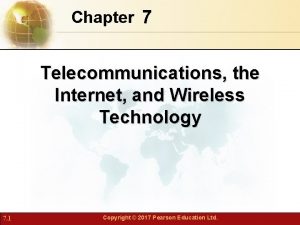Chapter 6 Telecommunications the Internet and Wireless Technology


















































- Slides: 50

Chapter 6 Telecommunications, the Internet, and Wireless Technology Video Cases: Case 1 Cisco Telepresence: Meeting without Traveling Case 2 Virtual Collaboration for Lotus Sametime 6. 1 Copyright © 2013 Pearson Education, Inc. publishing as Prentice Hall

Essentials of Management Information Systems Chapter 6 Telecommunications, the Internet, and Wireless Technology STUDENT LEARNING OBJECTIVES • What are the principal components of telecommunications networks and key networking technologies? • What are the main telecommunications transmission media and types of networks? • How do the Internet and Internet technology work and how do they support communication and e-business? 6. 2 Copyright © 2013 Pearson Education, Inc. publishing as Prentice Hall

Essentials of Management Information Systems Chapter 6 Telecommunications, the Internet, and Wireless Technology STUDENT LEARNING OBJECTIVES • What are the principal technologies and standards for wireless networking, communication, and Internet access? • Why are radio frequency identification (RFID) and wireless sensor networks valuable for business? 6. 3 Copyright © 2013 Pearson Education, Inc. publishing as Prentice Hall

Essentials of Management Information Systems Chapter 6 Telecommunications, the Internet, and Wireless Technology Hyundai Heavy Industries Creates a Wireless Shipyard • Problem: Systems can’t track inventory in 4. 2 sq mi shipyard in realtime • Solution: Highspeed wireless network using radio sensors web cams, and more 6. 4 Copyright © 2013 Pearson Education, Inc. publishing as Prentice Hall

Essentials of Management Information Systems Chapter 6 Telecommunications, the Internet, and Wireless Technology Hyundai Heavy Industries Creates a Wireless Shipyard • KT Corp builds high-speed wireless network using radio sensors, notebooks, mobiles, Web cams, and connected to electric lines in ships to overcome transmission problems cause by ship hulls • Demonstrates powerful capabilities and solutions offered by contemporary networking technology • Illustrates use of radio sensor technologies to track inventory 6. 5 Copyright © 2013 Pearson Education, Inc. publishing as Prentice Hall

Essentials of Management Information Systems Chapter 6 Telecommunications, the Internet, and Wireless Technology Hyundai Heavy Industries Creates a Wireless Shipyard 6. 6 Copyright © 2013 Pearson Education, Inc. publishing as Prentice Hall

Essentials of Management Information Systems Chapter 6 Telecommunications, the Internet, and Wireless Technology Telecommunications and Networking in Today’s Business World Networking and Communication Trends • Convergence: • Telephone networks and computer networks converging into single digital network using Internet standards • Cable companies providing voice service • Broadband: • More than 68% U. S. Internet users have broadband access • Broadband wireless: • Voice and data communication as well as Internet access are increasingly taking place over broadband wireless platforms 6. 7 Copyright © 2013 Pearson Education, Inc. publishing as Prentice Hall

Essentials of Management Information Systems Chapter 6 Telecommunications, the Internet, and Wireless Technology Telecommunications and Networking in Today’s Business World What Is a Computer Network? • Two or more connected computers • Major components in simple network • • • Client computer Server computer Network interfaces (NICs) Connection medium Network operating system Hub or switch • Routers • Device used to route packets of data through different networks, ensuring that data sent gets to the correct address 6. 8 Copyright © 2013 Pearson Education, Inc. publishing as Prentice Hall

Essentials of Management Information Systems Chapter 6 Telecommunications, the Internet, and Wireless Technology Telecommunications and Networking in Today’s Business World Components of a Simple Computer Network Illustrated here is a very simple computer network, consisting of computers, a network operating system residing on a dedicated server computer, cabling (wiring) connecting the devices, network interface cards (NIC), switches, and a router. 6. 9 Figure 6 -1 Copyright © 2013 Pearson Education, Inc. publishing as Prentice Hall

Essentials of Management Information Systems Chapter 6 Telecommunications, the Internet, and Wireless Technology Telecommunications and Networking in Today’s Business World Networks in Large Companies • Components can include: • Hundreds of local area networks (LANs) linked to firm-wide corporate network • Various powerful servers • • 6. 10 Web site Corporate intranet, extranet Backend systems Mobile wireless LANs (Wi-Fi networks) Videoconferencing system Telephone network Wireless cell phones Copyright © 2013 Pearson Education, Inc. publishing as Prentice Hall

Essentials of Management Information Systems Chapter 6 Telecommunications, the Internet, and Wireless Technology Telecommunications and Networking in Today’s Business World Corporate Network Infrastructure Today’s corporate network infrastructure is a collection of many different networks from the public switched telephone network, to the Internet, to corporate local area networks linking workgroups, departments, or office floors. Figure 6 -2 6. 11 Copyright © 2013 Pearson Education, Inc. publishing as Prentice Hall

Essentials of Management Information Systems Chapter 6 Telecommunications, the Internet, and Wireless Technology Telecommunications and Networking in Today’s Business World Key Digital Networking Technologies • Client/server computing • Distributed computing model • Clients linked through network controlled by network server computer • Server sets rules of communication for network and provides every client with an address so others can find it on the network • Has largely replaced centralized mainframe computing • The Internet: largest implementation of client/server computing 6. 12 Copyright © 2013 Pearson Education, Inc. publishing as Prentice Hall

Essentials of Management Information Systems Chapter 6 Telecommunications, the Internet, and Wireless Technology Telecommunications and Networking in Today’s Business World Key Digital Networking Technologies • Packet switching • Method of slicing digital messages into parcels (packets), sending packets along different communication paths as they become available, and then reassembling packets at destination • Previous circuit-switched networks required assembly of complete point-to-point circuit • Packet switching more efficient use of network’s communications capacity 6. 13 Copyright © 2013 Pearson Education, Inc. publishing as Prentice Hall

Essentials of Management Information Systems Chapter 6 Telecommunications, the Internet, and Wireless Technology Telecommunications and Networking in Today’s Business World Packet-Switched Networks and Packet Communications Data are grouped into small packets, which are transmitted independently over various communications channels and reassembled at their final destination. Figure 6 -3 6. 14 Copyright © 2013 Pearson Education, Inc. publishing as Prentice Hall

Essentials of Management Information Systems Chapter 6 Telecommunications, the Internet, and Wireless Technology Telecommunications and Networking in Today’s Business World Key Digital Networking Technologies • TCP/IP and connectivity • Connectivity between computers enabled by protocols • Protocols: rules that govern transmission of information between two points • Transmission Control Protocol/Internet Protocol (TCP/IP) • Common worldwide standard that is basis for Internet • Department of Defense reference model for TCP/IP • Four layers • Application layer • Transport layer • Internet layer • Network interface layer 6. 15 Copyright © 2013 Pearson Education, Inc. publishing as Prentice Hall

Essentials of Management Information Systems Chapter 6 Telecommunications, the Internet, and Wireless Technology Telecommunications and Networking in Today’s Business World The Transmission Control Protocol/Internet Protocol (TCP/IP) Reference Model This figure illustrates the four layers of the TCP/IP reference model for communications. Figure 6 -4 6. 16 Copyright © 2013 Pearson Education, Inc. publishing as Prentice Hall

Essentials of Management Information Systems Chapter 6 Telecommunications, the Internet, and Wireless Technology Communications Networks Types of Networks • Signals: digital versus analog • Modem: translates digital signals into analog form • Local-area networks (LANs) • Peer-to-peer • Client/server • Topologies: star, bus, ring • Metropolitan and wide-area networks • Wide-area networks (WANs) • Metropolitan-area networks (MANs) 6. 17 Copyright © 2013 Pearson Education, Inc. publishing as Prentice Hall

Essentials of Management Information Systems Chapter 6 Telecommunications, the Internet, and Wireless Technology Communications Networks Functions of the Modem A modem is a device that translates digital signals into analog form (and vice versa) so that computers can transmit data over analog networks such as telephone and cable networks. Figure 6 -5 6. 18 Copyright © 2013 Pearson Education, Inc. publishing as Prentice Hall

Essentials of Management Information Systems Chapter 6 Telecommunications, the Internet, and Wireless Technology Communications Network Topologies The three basic network topologies are the bus, star, and ring. Figure 6 -6 6. 19 Copyright © 2013 Pearson Education, Inc. publishing as Prentice Hall

Essentials of Management Information Systems Chapter 6 Telecommunications, the Internet, and Wireless Technology Communications Networks Physical Transmission Media • Twisted pair wire (modems) Ttype of wiring in which two conductors of a single circuit are twisted together • Coaxial cable • • Type of cable that has an inner conductor surrounded by a tubular insulating layer Fiber optics and optical networks • is a flexible, transparent fiber made of high quality glass (silica) or plastic, slightly thicker than a human hair • Dense wavelength division multiplexing (DWDM) 6. 20 Copyright © 2013 Pearson Education, Inc. publishing as Prentice Hall

• Wireless transmission media and devices • Microwave • Satellites • Cellular systems • Wireless communication technology in which several small exchanges (called cells) equipped with low-power radio antennas (strategically located over a wide geographical area) are interconnected through a central exchange. As a receiver (cell phone) moves from one place to the next, its identity, location, and radio frequency is handed-over by one cell to another without interrupting a call • https: //www. youtube. com/watch? v=n. LYh. MWx 8 g-o • Transmission speed (hertz, bandwidth) • 6. 21 Bandwidth (signal processing) or analog bandwidth, frequency bandwidth or radio bandwidth: a measure of the width of a range of frequencies, measured in hertz Copyright © 2013 Pearson Education, Inc. publishing as Prentice Hall

Essentials of Management Information Systems Chapter 6 Telecommunications, the Internet, and Wireless Technology Communications Networks BP Amoco’s Satellite Transmission System Communication satellites help BP Amoco transfer seismic data between oil exploration ships and research centers in the United States. Figure 6 -7 6. 22 Copyright © 2013 Pearson Education, Inc. publishing as Prentice Hall

Essentials of Management Information Systems Chapter 6 Telecommunications, the Internet, and Wireless Technology The Global Internet What Is the Internet? • • World’s most extensive network Internet service providers (ISPs) • is an organization that provides services for accessing, using, or participating in the Internet • Dial-up • uses telephone network • capable only of 56 kbps or lower • • Digital subscriber line (DSL) • using a separate line • DSL speeds can go from several hundred kbps to around 8 Mbps Cable Internet connection (transmits digital data over existing cable television lines. ) • T 1 lines (used by businesses that need reliable bandwidth for their day to day operations and can’t afford any downtime) 6. 23 Copyright © 2013 Pearson Education, Inc. publishing as Prentice Hall

Essentials of Management Information Systems Chapter 6 Telecommunications, the Internet, and Wireless Technology The Global Internet • Internet addressing and architecture • IP addresses • is a numerical label assigned to each device (e. g. , computer, printer) participating in a computer network that uses the Internet Protocol for communication • The Domain Name System (DNS) converts IP addresses to domain names • Hierarchical structure • Top-level domains • Internet architecture and governance • No formal management: IAB, ICANN, W 3 C 6. 24 Copyright © 2013 Pearson Education, Inc. publishing as Prentice Hall

• The future Internet: IPv 6 and Internet 2 • • Internet Protocol version 6 (IPv 6) is the latest version of the Internet Protocol (IP), the communications protocol that provides an identification and location system for computers on networks and routes traffic across the Internet IPv 6 is intended to replace IPv 4 – 6. 25 EXAMPLE 31. 13. 64. 1 Copyright © 2013 Pearson Education, Inc. publishing as Prentice Hall

Essentials of Management Information Systems Chapter 6 Telecommunications, the Internet, and Wireless Technology The Global Internet The Domain Name System is a hierarchical system with a root domain, top -level domains, second -level domains, and host computers at the third level. https: //www. youtube. com/watch? v=s. A BA 3 S 1 Ntl. E Figure 6 -8 6. 26 Copyright © 2013 Pearson Education, Inc. publishing as Prentice Hall

Essentials of Management Information Systems Chapter 6 Telecommunications, the Internet, and Wireless Technology The Global Internet Network Architecture The Internet backbone connects to regional networks, which in turn provide access to Internet service providers, large firms, and government institutions. Network access points (NAPs) and metropolitan area exchanges (MAEs) are hubs where the backbone intersects regional and local networks and where backbone owners connect with one another. Figure 6 -9 6. 27 Copyright © 2013 Pearson Education, Inc. publishing as Prentice Hall

Essentials of Management Information Systems Chapter 6 Telecommunications, the Internet, and Wireless Technology The Global Internet Interactive Session: Organizations The Battle Over Net Neutrality • Read the Interactive Session and then discuss the following questions: • What is network neutrality? Why has the Internet operated under net neutrality up to this point in time? • Who’s in favor of network neutrality? Who’s opposed? Why? • What would be the impacts on individual users, businesses, and government if Internet providers switched to a tiered service model? • Are you in favor of legislation enforcing network neutrality? Why or why not? 6. 28 Copyright © 2013 Pearson Education, Inc. publishing as Prentice Hall

Essentials of Management Information Systems Chapter 6 Telecommunications, the Internet, and Wireless Technology The Global Internet Services • Internet services • E-mail • Chatting and instant messaging • Newsgroups • Telnet (Telnet offers users the capability of running programs remotely and facilitates remote administration. ) • File Transfer Protocol (FTP) • World Wide Web • Vo. IP • Unified communications (is the integration of real-time communication services such as instant messaging, video conferencing) • Virtual private network (VPN) • 6. 29 A virtual private network (VPN) extends a private network across a public network, such as the Internet Copyright © 2013 Pearson Education, Inc. publishing as Prentice Hall

Essentials of Management Information Systems Chapter 6 Telecommunications, the Internet, and Wireless Technology The Global Internet Client/Server Computing on the Internet Figure 6 -10 Client computers running Web browser and other software can access an array of services on servers over the Internet. These services may all run on a single server or on multiple specialized servers. 6. 30 Copyright © 2013 Pearson Education, Inc. publishing as Prentice Hall

Essentials of Management Information Systems Chapter 6 Telecommunications, the Internet, and Wireless Technology The Global Internet How Voice over IP Works A Vo. IP phone call digitizes and breaks up a voice message into data packets that may travel along different routes before being reassembled at the final destination. A processor nearest the call’s destination, called a gateway, arranges the packets in the proper order and directs them to the telephone number of the receiver or the IP address of the receiving computer. Figure 6 -11 6. 31 Copyright © 2013 Pearson Education, Inc. publishing as Prentice Hall

Essentials of Management Information Systems Chapter 6 Telecommunications, the Internet, and Wireless Technology The Global Internet A Virtual Private Network Using the Internet Figure 6 -12 This VPN is a private network of computers linked using a secure “tunnel” connection over the Internet. It protects data transmitted over the public Internet by encoding the data and “wrapping” them within the Internet Protocol (IP). By adding a wrapper around a network message to hide its content, organizations can create a private connection that travels through the public Internet. 6. 32 Copyright © 2013 Pearson Education, Inc. publishing as Prentice Hall

Essentials of Management Information Systems Chapter 6 Telecommunications, the Internet, and Wireless Technology The Global Internet Interactive Session: People Monitoring Employees on Networks—Unethical or Good Business? • Read the Interactive Session and then discuss the following questions: • Should managers monitor employee e-mail and Internet usage? Why or why not? • Describe an effective e-mail and Web use policy for a company. • Should managers inform employees that their Web behavior is being monitored? Or should managers monitor secretly? Why or why not? 6. 33 Copyright © 2013 Pearson Education, Inc. publishing as Prentice Hall

Essentials of Management Information Systems Chapter 6 Telecommunications, the Internet, and Wireless Technology The Global Internet The World Wide Web • HTML (Hypertext Markup Language): • • Hypertext Transfer Protocol (HTTP): • • Addresses of Web pages E. g. , http: //www. megacorp. com/content/features/082602. html Web servers • 6. 34 Communications standard used for transferring Web pages Uniform resource locators (URLs): • • • Formats documents for display on Web Software for locating and managing Web pages Copyright © 2013 Pearson Education, Inc. publishing as Prentice Hall

Essentials of Management Information Systems Chapter 6 Telecommunications, the Internet, and Wireless Technology The Global Internet The World Wide Web • Search engines • • • 6. 35 Started in early 1990 s as relatively simple software programs using keyword indexes Mobile search—now 15% of all searches in 2011 Search engine marketing—major source of Internet advertising revenue SEO—process of improving rankings in search engine results Social search—Google +1, Facebook Like Shopping bots—Use intelligent agent software for searching Internet for shopping information Copyright © 2013 Pearson Education, Inc. publishing as Prentice Hall

Essentials of Management Information Systems Chapter 6 Telecommunications, the Internet, and Wireless Technology The Global Internet Top U. S. Web Search Engines Figure 6 -13 Google is the most popular search engine on the Web, handling 84% of all Web searches. 6. 36 Copyright © 2013 Pearson Education, Inc. publishing as Prentice Hall

Essentials of Management Information Systems Chapter 6 Telecommunications, the Internet, and Wireless Technology The Global Internet How Google Works The Google search engine is continuously crawling the Web, indexing the content of each page, calculating its popularity, and storing the pages so that it can respond quickly to user requests to see a page. The entire process takes about one-half second. Figure 6 -14 6. 37 Copyright © 2013 Pearson Education, Inc. publishing as Prentice Hall

Essentials of Management Information Systems Chapter 6 Telecommunications, the Internet, and Wireless Technology The Global Internet The World Wide Web • Web 2. 0 6. 38 • Second-generation services enabling people to collaborate, share information, and create new services online • Blogs: chronological, informal Web sites created by individuals • RSS (Really Simple Syndication): syndicates Web content so aggregator software can pull content for use in another setting or viewing later • Wikis: collaborative Web sites where visitors can add, delete, or modify content on the site • Social networking sites—enable users to build communities of friends and share information Copyright © 2013 Pearson Education, Inc. publishing as Prentice Hall

Essentials of Management Information Systems Chapter 6 Telecommunications, the Internet, and Wireless Technology The Global Internet Web 3. 0 • “Semantic Web” • A collaborative effort led by W 3 C to add layer of meaning to the existing Web • The World Wide Web Consortium (W 3 C) is an international community that develops open standards to ensure the long-term growth of the Web • Goal is to reduce human effort in searching for and processing information • Ways to make Web more “intelligent” and intuitive • Increased communication and synchronization with computing devices, communities • More widespread use of cloud computing, mobile computing 6. 39 Copyright © 2013 Pearson Education, Inc. publishing as Prentice Hall

Essentials of Management Information Systems Chapter 6 Telecommunications, the Internet, and Wireless Technology The Wireless Revolution • Cellular systems • Competing standards for cellular service • CDMA (Code Division Multiple Access): United States only • GSM (Global System for Mobile): rest of world • The major difference between the two technologies is how they turn voice data into radio waves and how the carrier connects to the phone. Other differences include the coverage area, the data transfer speeds, and the type of hardware used • Third-generation (3 G) networks • Higher transmission speeds suitable for broadband Internet access • Fourth-generation (4 G) networks • 6. 40 provides mobile ultra-broadband Internet access, for example to laptops with USB wireless modems, to smartphones, Copyright © 2013 Pearson Education, Inc. publishing as Prentice Hall

Essentials of Management Information Systems Chapter 6 Telecommunications, the Internet, and Wireless Technology The Wireless Revolution • Wireless computer networks and Internet access • Bluetooth (802. 15) • Links up to 8 devices in 10 -m area using low-power, radiobased communication • Useful for personal networking (PANs) • Wi-Fi (802. 11) -Wireless Fidelity • Set of standards: 802. 11 a, 802. 11 b, 802. 11 g, 802. 11 n • Used for wireless LAN and wireless Internet access • Use access points: device with radio receiver/transmitter for connecting wireless devices to a wired LAN 6. 41 Copyright © 2013 Pearson Education, Inc. publishing as Prentice Hall

Essentials of Management Information Systems Chapter 6 Telecommunications, the Internet, and Wireless Technology The Wireless Revolution A Bluetooth Network (PAN) Bluetooth enables a variety of devices, including cell phones, PDAs, wireless keyboards and mice, PCs, and printers, to interact wirelessly with each other within a small 30 -foot (10 meter) area. In addition to the links shown, Bluetooth can be used to network similar devices to send data from one PC to another, for example. Figure 6 -15 6. 42 Copyright © 2013 Pearson Education, Inc. publishing as Prentice Hall

Essentials of Management Information Systems Chapter 6 Telecommunications, the Internet, and Wireless Technology The Wireless Revolution An 802. 11 Wireless LAN Mobile laptop computers equipped with wireless network interface cards link to the wired LAN by communicating with the access point. The access point uses radio waves to transmit network signals from the wired network to the client adapters, which convert them into data that the mobile device can understand. The client adapter then transmits the data from the mobile device back to the access point, which forward the data to the wired network. Figure 6 -16 6. 43 Copyright © 2013 Pearson Education, Inc. publishing as Prentice Hall

Essentials of Management Information Systems Chapter 6 Telecommunications, the Internet, and Wireless Technology The Wireless Revolution • Wireless computer networks and Internet access • Wi-Fi (cont. ) • Hotspots: one or more access points in public place to provide maximum wireless coverage for a specific area • Weak security features • Wi. Max (802. 16) • Wireless access range of 31 miles • Require Wi. Max antennas 6. 44 Copyright © 2013 Pearson Education, Inc. publishing as Prentice Hall

Essentials of Management Information Systems Chapter 6 Telecommunications, the Internet, and Wireless Technology The Wireless Revolution • Radio frequency identification (RFID) 6. 45 • Use tiny tags with embedded microchips containing data about an item and location • Tags transmit radio signals over short distances to special RFID readers, which send data over network to computer for processing • Active RFID: tags have batteries, data can be rewritten, range is hundreds of feet, more expensive • Passive RFID: range is shorter, also smaller, less expensive, powered by radio frequency energy Copyright © 2013 Pearson Education, Inc. publishing as Prentice Hall

Essentials of Management Information Systems Chapter 6 Telecommunications, the Internet, and Wireless Technology The Wireless Revolution • Radio frequency identification (RFID) • 6. 46 Common uses: • Automated toll-collection • Tracking goods in a supply chain • Requires companies to have special hardware and software • Reduction in cost of tags making RFID viable for many firms Copyright © 2013 Pearson Education, Inc. publishing as Prentice Hall

Essentials of Management Information Systems Chapter 6 Telecommunications, the Internet, and Wireless Technology The Wireless Revolution How RFID Works Figure 6 -17 RFID uses low-powered radio transmitters to read data stored in a tag at distances ranging from 1 inch to 100 feet. The reader captures the data from the tag and sends them over a network to a host computer for processing. 6. 47 Copyright © 2013 Pearson Education, Inc. publishing as Prentice Hall

Essentials of Management Information Systems Chapter 6 Telecommunications, the Internet, and Wireless Technology The Wireless Revolution • Wireless sensor networks (WSNs) • Networks of hundreds or thousands of interconnected wireless devices embedded into physical environment to provide measurements of many points over large spaces • Used to monitor building security, detect hazardous substances in air, monitor environmental changes, traffic, or military activity • Devices have built-in processing, storage, and radio frequency sensors and antennas • Require low-power, long-lasting batteries and ability to endure in the field without maintenance 6. 48 Copyright © 2013 Pearson Education, Inc. publishing as Prentice Hall

Essentials of Management Information Systems Chapter 6 Telecommunications, the Internet, and Wireless Technology The Wireless Revolution A Wireless Sensor Network The small circles represent lower-level nodes and the larger circles represent high -end nodes. Lowerlevel nodes forward data to each other or to higher-level nodes, which transmit data more rapidly and speed up network performance. Figure 6 -18 6. 49 Copyright © 2013 Pearson Education, Inc. publishing as Prentice Hall

6. 50 Copyright © 2013 Pearson Education, Inc. publishing as Prentice Hall
 Telecommunications, the internet, and wireless technology
Telecommunications, the internet, and wireless technology Telecommunications the internet and wireless technology
Telecommunications the internet and wireless technology Wireless telecommunications industry analysis
Wireless telecommunications industry analysis Information technology the internet and you
Information technology the internet and you Chapter 1 information technology the internet and you
Chapter 1 information technology the internet and you Boston scientific latitude wireless adapter
Boston scientific latitude wireless adapter Q wireless internet
Q wireless internet A type of wireless local area network technology
A type of wireless local area network technology Wireless communication history
Wireless communication history Means communication at a distance
Means communication at a distance Electronics and telecommunications research institute
Electronics and telecommunications research institute Introduction to telecommunication
Introduction to telecommunication What is internet
What is internet A pioneer in the field of telecommunications
A pioneer in the field of telecommunications Project management telecommunications
Project management telecommunications Osha telecommunications standards
Osha telecommunications standards Sierra leone telecommunications company
Sierra leone telecommunications company Telecommunications act of 1996
Telecommunications act of 1996 Venture capital telecommunications
Venture capital telecommunications In a telecommunications network architecture, a protocol is
In a telecommunications network architecture, a protocol is Telecommunications infrastructure standard for data centers
Telecommunications infrastructure standard for data centers Tmn model is defined by
Tmn model is defined by Telecommunications for dummies
Telecommunications for dummies Disaster recovery telecommunications
Disaster recovery telecommunications Danswers
Danswers Government emergency telecommunications service
Government emergency telecommunications service Telecommunications engineering
Telecommunications engineering Telecommunications for dummies
Telecommunications for dummies Department of telecommunications
Department of telecommunications Department of telecommunications
Department of telecommunications French telecommunications equipment company
French telecommunications equipment company Digital telecommunications
Digital telecommunications Iu telecommunications
Iu telecommunications European telecommunications standards institute
European telecommunications standards institute Ee3801
Ee3801 Government emergency telecommunications service
Government emergency telecommunications service International telecommunications society
International telecommunications society Gts telecommunications
Gts telecommunications Strategy and the internet michael porter
Strategy and the internet michael porter Internet technology
Internet technology Internet technology wikipedia
Internet technology wikipedia Hát kết hợp bộ gõ cơ thể
Hát kết hợp bộ gõ cơ thể Lp html
Lp html Bổ thể
Bổ thể Tỉ lệ cơ thể trẻ em
Tỉ lệ cơ thể trẻ em Gấu đi như thế nào
Gấu đi như thế nào Tư thế worms-breton
Tư thế worms-breton Chúa yêu trần thế alleluia
Chúa yêu trần thế alleluia Các môn thể thao bắt đầu bằng từ đua
Các môn thể thao bắt đầu bằng từ đua Thế nào là hệ số cao nhất
Thế nào là hệ số cao nhất Các châu lục và đại dương trên thế giới
Các châu lục và đại dương trên thế giới
